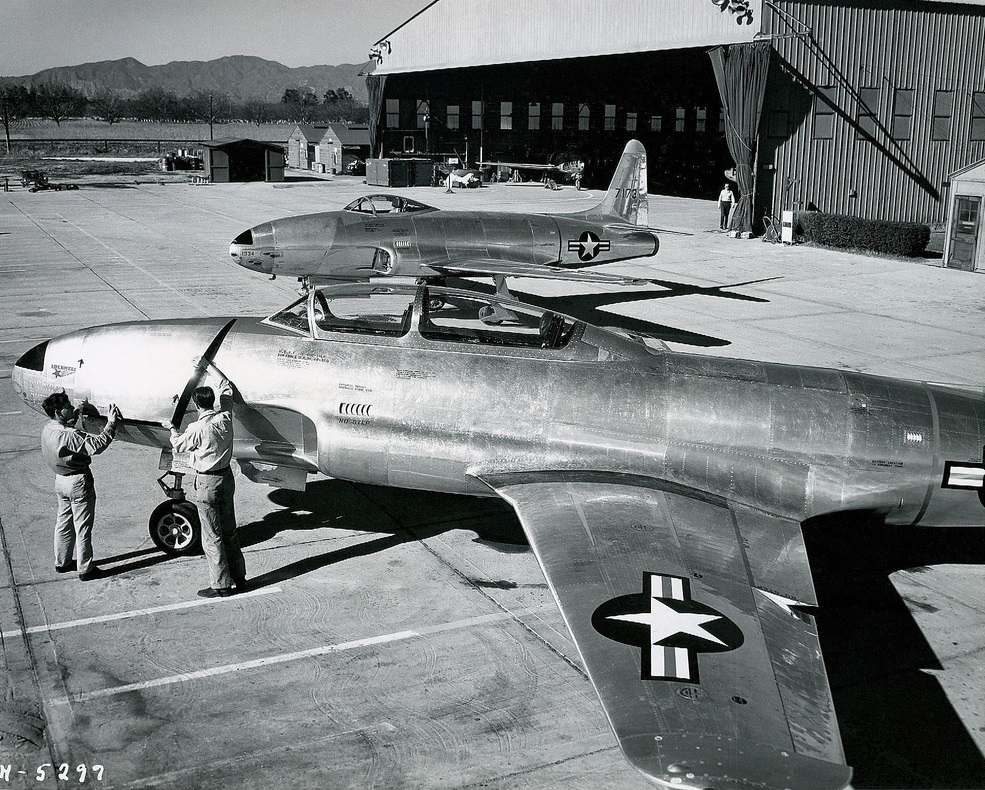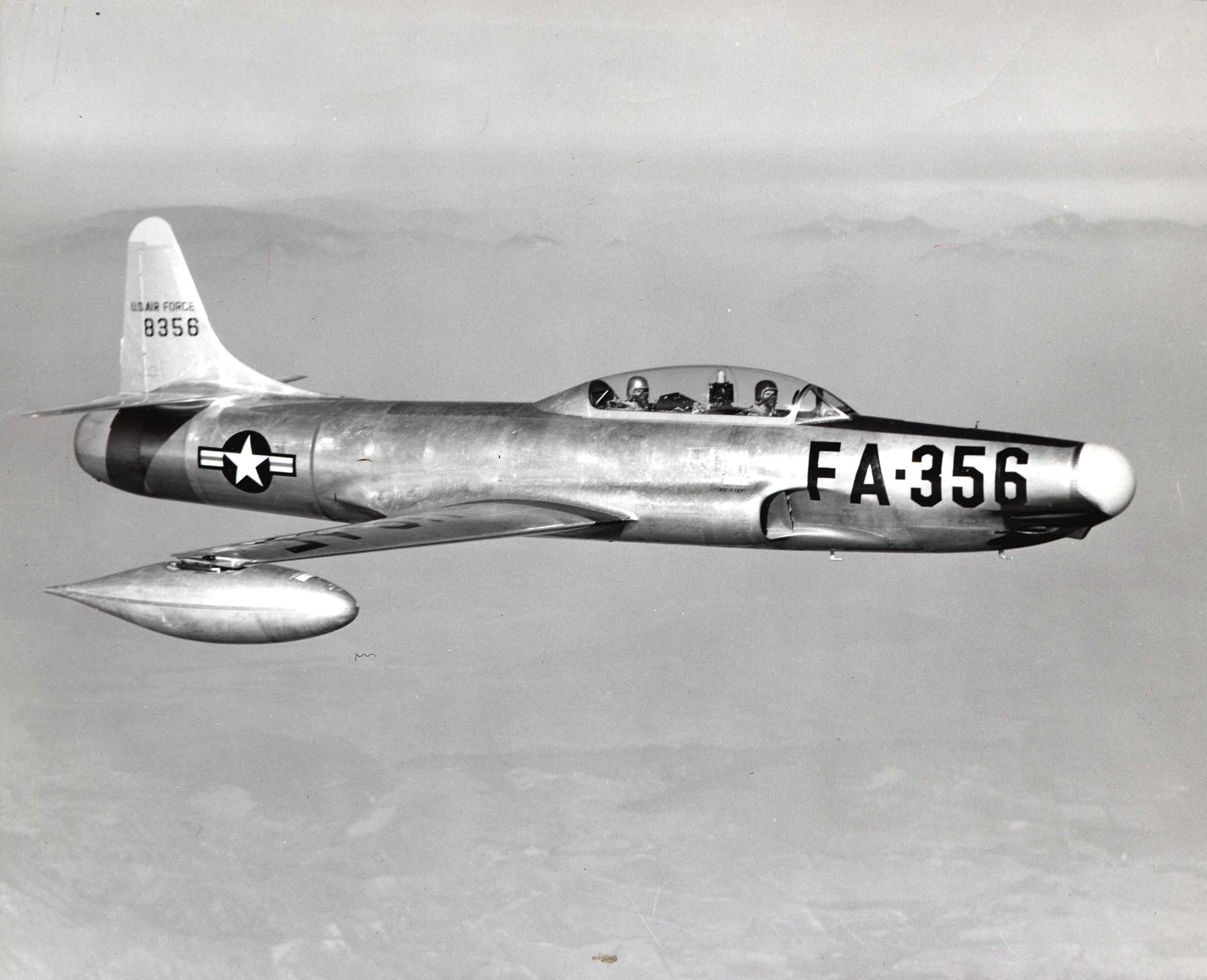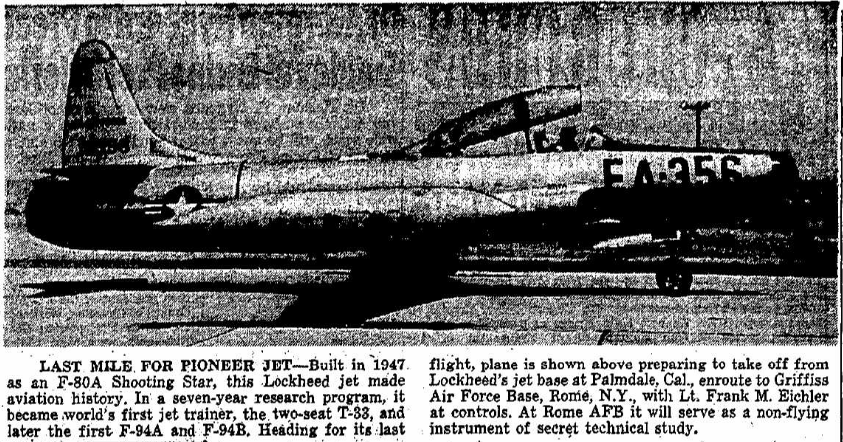19 August 1954: The Valley News reported:
‘Old Hodgepodge’, Lockheed’s Doughty Jet, Retiring to Scientific Service on Ground
Skyworn and airweary, but still full of flight, the grand-daddy of Lockheed jets has dodged the junkman’s grimy grip and flown proudly from California to new York to sit out the rest of its life on the ground, but still in the service of science. A last minute reprieve from the U.S. Air Force spared from destruction Old Hodgepodge, a research plane that flew as four different models of advanced aircraft designs and led to $500,000,000 worth of jets for United States fighting forces.
Many times modified and too often patched in seven years of aerial contortions, the test jet had been relegated to the scrapheap. It was declared no longer safe for combat or further flight experiment.
Busy Every Day
But, USAF officials later decided, it could continue in use at Griffiss Air Force Base, Rome, N.Y., as a nonflying instrument of a secret technical study. It was ferried to Griffiss AFB from Lockheed’s Palmdale jet base by Lt. Frank M. Eichler.
How Old Hodgepodge came to such an unusual end is a tale of home [sic] new and better airplanes are born.
The plane was first built in 1947 as an F-80A Shooting Star, America’s first quantity jet design.
Then it was sliced in half to be expanded into the world’s first jet trainer, the two-seat T-33.
It got new engines—and magic radar—to become the first F-94A interceptor.
Then it donned a new kind of wingtip fuel tank and was the F-94B.
Became Dean Emeritus
It then took on and tested electronic and rocket inventions designed for the F-94C, today’s all-weather and all-rocket interceptor flying invasion watch from USAF bases.
Yesterday the 40-foot-long jet-job was a brawling daredevil of science that withstood ice and lightning and screeching dives and twisting spins. One minute it was being pampered by research engineers and mechanics, the next it was undergoing aerial wringout at the hands of Lockheed’s best test pilots.
The ship spent 546 hours in the air in tests. It made 772 research flights—773 counting the last-mile dash to New York.
After shaping the course of jet pilot training for most of the world, it helped develop today’s super-performance fighters and even engaged in guided missile experiments.
As the T-33 prototype, it became the dean emeritus of jet trainers. U.S. Air Force, Navy and Marine pilots learned jet flying in its offspring, as did the pilots of a dozen friendly nations.
Checked Out Rockets
As a flying drawing board it pioneered advanced engines, radar, radomes, deicers, rocket pods, fuel tanks and cockpit canopies.
When fitted with a wooden nose, a model of the first Starfire’s radar nose, it gained the nickname “Pinocchio.”
Then it became the first jet to carry a combination search and rocket fire-control radar system, first jet to have a long clamshell canopy, first to wear a plastic radome nose designed for the Starfire’s radar system.
Scientists rigged pods to hold rockets on its wings, thus doubling the hall-rocket Starfire’s firepower.
They gave the plane an afterburner, leading to improvement of the double-jet type engines used in today’s fastest turbine planes.
It flew on a half-dozen different engines. Its power increased from 3800 pounds of thrust to about 6000 pounds.
Moving from scientific job to scientific job, the airplane became an unrecognizable conglomerate. It contained experimental devices applied to no other airplane in the world.
Even Foiled Lightning
Its first flight as a trainer came March 22, 1948, with Chief Engineering Test Pilot A. W. (Tony) LeVier at the controls. Eight days and three flights later LeVier took up F. E. Gaiser, flight-test engineer, first passenger ever to ride in a production jet trainer.
In Lockheed’s test and experimental program, pilots tried to fly the wings off the plane in stability, spin, speed and dive tests.
They caked ice on the wing, nose and cockpit and then used unusual deicing equipment to “defrost” accumulations up to two inches thickness. “Metal sandwich” wings operating on high voltage were one type; a millionth-inch-thick spray was another.
On one derring-do mission, Pilot Stanley Baltz and Engineer E. L. Joiner Jr., purposely flew the airplane in zero visibility through cloud, cold and night when all other planes were grounded—just to ice up the wings and test foul-weather performance.
That night lightning struck and burned a hole in the wing, but Old Hodgepodge flew on in full control.
Under Own Power
Gradually the laboratory plane’s test role faded because newer concepts and models were coming forward. Old Hodgepodge was assigned less glamorous jobs—radar target ship and missile chase plane.
Eventually it became to fat and sluggish for arduous scientific duties. It was more of a crazy quilt than a magic carpet, no longer fit for any Air Force squadron.
At the end it had to carry 1000 pounds of ballast in its nose to maintain balance in flight. Takeoff weight was up to about nine tons instead of the original seven tons.
Into teh blue she knew so well, the old plane has flown off to anonymity, but—to her everlasting credit—she got there on her own power and her own wings.
—The Valley News, Vol. 34, No. 10, 19 August 1954, Page 9-C, Columns 3–6

Originally a P-80C Shooting Star single-place fighter, 48-356 had been modified at Lockheed Plant B-9 in Van Nuys to become the prototype TP-80C two-place jet trainer (the designation was soon changed to T-33A), which first flew 22 March 1948. It was then modified as the prototype YF-94. 48-356 was later modified as the prototype F-94B. 48-356 was on static display at Lackland Air Force Base, Texas, for many years. It is in the collection of the Air Force Flight Test Museum, Edwards Air Force Base, and is in storage awaiting restoration.

© 2023, Bryan R. Swopes
